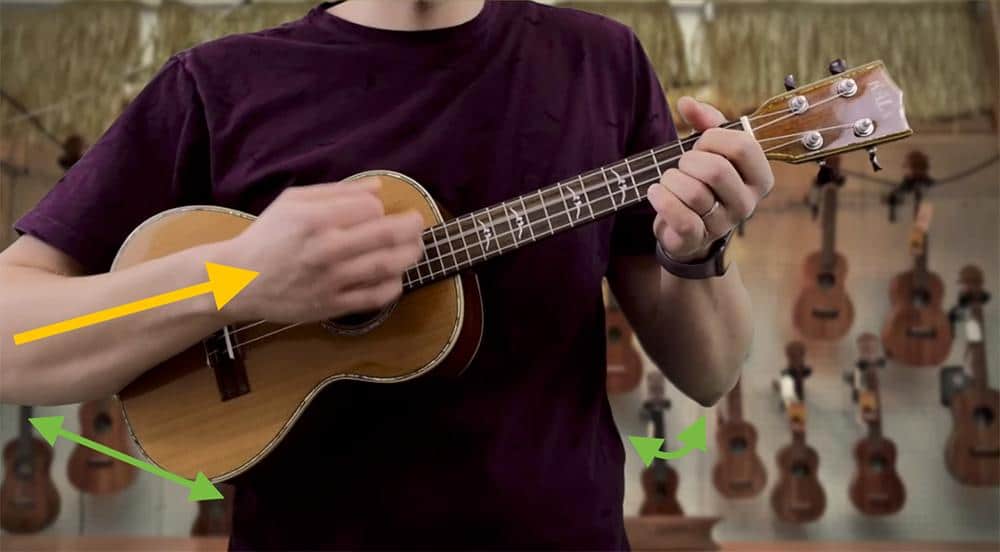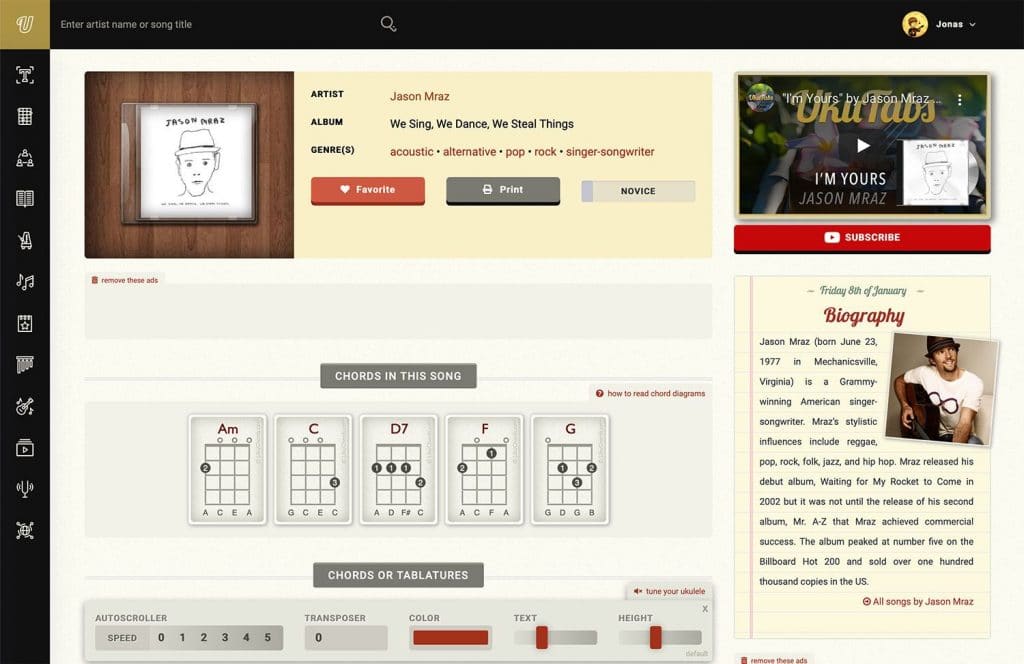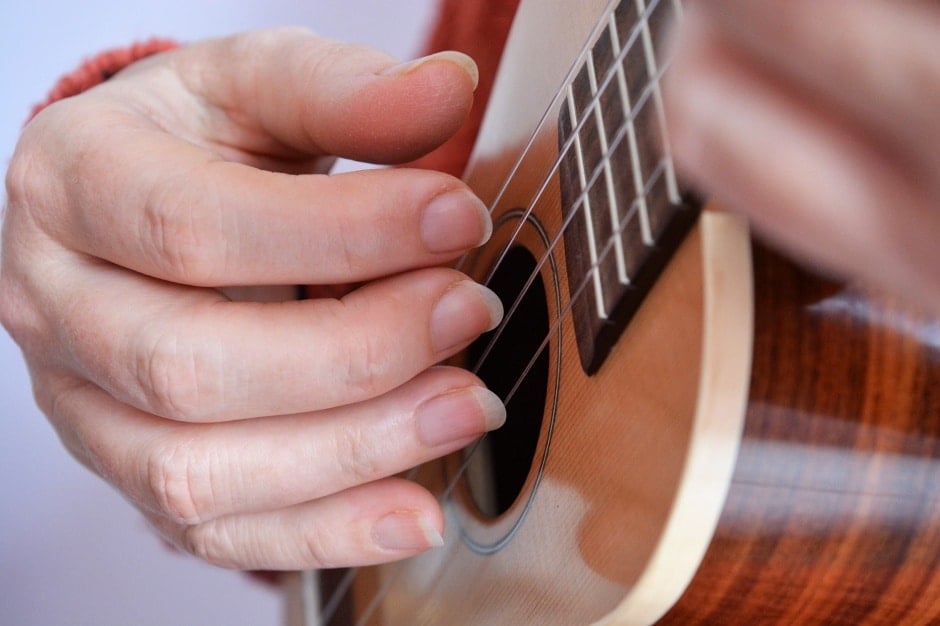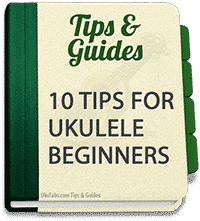Have you just picked up your first ukulele? Or are you thinking about starting to play? Read these 10 ukulele tips for beginners first! There are quite a few lists of top 10 tips like these out there on the internet. But I’ll try to add some personal stuff and tips of my own. Read on!
Ukulele tips for beginners: 1 to 5
When I bought my first ukulele I was completely unprepared, but I had the benefit of some guitar background. I’ll try to give you some really useful tips that will give you a jump-start when you start playing the ukulele. Be sure to check out the things to know before you buy and ukulele buying guide as well.
1. Get a decent ukulele
This is the most important tip of all for ukulele beginners if you are serious about wanting to learn how to play the ukulele. There are a few good ukuleles in the $100 range, but you can be almost sure that an ukulele under $50 will not be very good. The main issue you will have is that it won’t to stay in tune.
I’m speaking from experience. I bought a $45 “Harley Benton” soprano once and it couldn’t keep the E string in tune even for one strum. So be warned! Check out the ukulele buying guide to get the right ukulele for you — different ukuleles listed for all budgets — and, if you have the chance, try some ukuleles in your local music shop.
2. Learn how to hold your ukulele
This may sound stupid but it will come in really handy in the future! Take a few minutes to try some positions, either sitting or standing.

When you are sitting down, you can let the body of the ukulele rest on your leg. Rest your strumming arm on the top of the ukulele. The neck of the ukulele should be “floating” in the air. When you are standing up, you can hold it against your chest and keep it there with your strumming arm.
All this may take some practice, but it will pay off in the end because you will be able to pick up your ukulele and play – even when walking around – without messing about first. In my opinion, a strap is unnecessary and it just adds bulk to the ukulele. In some cases a strap might come in handy though. Check out how to add a ukulele strap to your ukulele without drilling.
I had some trouble at the beginning, but nowadays I walk around the house, go out into the garden or whatever with my ukulele. Here’s another quick tip: don’t hold it too tightly! The sound still needs to vibrate properly through the body.
3. Have fun!
The ukulele is a fun instrument. Some may call the ukulele a toy, but so what? Toys are fun to play with! But it really isn’t a toy at all, it’s a genuine instrument and you can do wonderful things with it. Don’t make the mistake of thinking that it is an easy instrument either. You will need a lot of practice to master it, but you will have so much fun even if you only know the basics!
Enjoy playing it and before you know it, you will have made great progress. Another very important ukulele tip for beginners: don’t give up too easily!
4. First things first: the basics
It only takes a quick look at YouTube and other websites to realise that amazing things can be done with the ukulele, but as with every skill in life, you’ll need to start by learning the basics.
Don’t try to play big fancy tabs when you are just starting out. Learn your basic chords instead. Start with the majors and minors and then go on to other chords. The UkuTabs chords chart is perfect for this, since it gives you a very decent overview of all the major chords.
You will notice that once you know your chords, you will be playing tons of songs without even thinking twice about how to play them. Also check out the UkuTabs Chord Library to see how to play every ukulele chord possible.
5. Decent strumming makes all the difference
At the start you’ll probably only be doing simple up and down, up and down, up and down. But after a while you can try to add some slapping and palm muting to really get that chunky, funky, groovy feeling. I won’t explain how to strum in here, but feel free to take a look at The Ultimate Strumming Guide.
Wondering why there aren’t any strumming patterns posted along with songs? Well, that’s a whole other story. It is forbidden by the MPA (Music Publishers Association) due to copyright issues. They say it is not allowed to share the instructions for how exactly to play a song online. So strumming patterns (rhythm and tempo) can’t be shared at all and I’m afraid there isn’t much I can do about that.
It will really help a lot if you try to figure out the strumming yourself. You will learn to play the ukulele a lot quicker and after a while you’ll come up with your own strumming patterns! Listen carefully to the song and “feel” the rhythm. I know this isn’t easy, but once you get the basics, you’ll be able to do it really quickly.
Ukulele tips for beginners: 6 to 10
6. Use UkuTabs.com to learn songs
Ha, so this may sound silly but it is actually one of the best ways to learn new songs, since each song on UkuTabs has the chord diagrams for every chord in that song. That way you won’t have to look up the chord diagrams.

What is more, if you hover over a chord in the song itself, the chord diagram will pop up! You can also transpose the key of a song to make the chords easier.
7. Play as slowly as you can
Once you have mastered your basic chords and can do some basic strumming, you can eventually start changing between chords. Practice this a lot and with many different chords. At first, do it as slowly as you can so that you can’t possibly make a mistake. Remember that the most important thing is to be accurate, not quick!
The same applies when you are starting out with tablatures. Make sure you get a clean sound with no buzzing and muting. Start with slow, easy songs with easy chords and not too many chord changes. Gradually speed up and try more difficult songs.
8. Listen to ukulele players and play along
Already in a band? Perfect! Bring your ukulele along and jam with your friends. Not in a band yet? No problem either: all you have to do is convince your friends to start playing the ukulele! And if that doesn’t work, turn on your computer, go online and watch ukulele videos that you can play along with. Or marvel at the real ukulele gurus out there!
All of this will help you to feel the ukulele “groove”. Watch and listen carefully for tempos and rhythms and before you know it, you’ll be learning how to play the ukulele!
9. Record yourself playing and listen to the recordings
I got this tip from the UkuleleHunt (maintained by Alistair Wood). It’s difficult to play and listen to yourself at the same time. Quite often, just noticing what you’re doing wrong is enough to fix the problem. It also gets you used to playing in front of the mic – so it is less of a big deal when you want to record yourself properly.
10. Fingering exercises
This might seem a lot of work. Besides learning chord shapes, how to strum, how to change chords quickly, etc., you’ll also need to do some fingering exercises. This will help you gradually build up calluses on your fingers (= toughened areas of skin which have become relatively hard and thick due to repeated friction or pressure).
This may sound like a weird thing to want to do, but it will help a lot in the end. One thing you will soon learn is that when you start playing stringed instruments, your fingers will hurt! Not as much with nylon strings as with steel stringed instruments, though. As your calluses develop, you’ll notice that your fingers hurt less.
I have found the exercise below by Faye Hicks to be really good.
Pluck the first string open, then with your index finger on (actually just behind) the first fret, then with your middle finger on the second fret, then with your ring finger on the third fret and finally with your pinkie finger on the fourth fret. Do the pinkie one twice and then work your way back down: ring finger on third fret, middle finger on second fret, index finger on the first fret, then open. Now move to the second string and repeat the pattern. Then the third string, then the fourth. Run through that a few times at the beginning of each practice. Not only will it toughen up your fingertips, it will limber up your fingers. You can also use this exercise to limber up your right hand too – by practicing different finger picking exercises as you do it. The second thing I found that helped in the early stages of toughening up the fingertips was to play for a short length of time (e.g. 10 to 15 minutes) several times a day, instead of playing for one long session (60 to 90 minutes).
You need to play at least 10-15 min every day to build up those calluses. So even if you only have time to run through the exercises a few times, do it! Your fingers will thank you later on.
Two good books with tons of exercise snippets and tips are “Ukulele Aerobics” by Chad and of course “Ukulele Exercises for Dummies” by Brett and Al.
An extra ukulele tip for beginners: number 11
11. One final tip
Your fingernails should be cut VERY short on your fretting hand! This is vital if you want to get a clean sound, because you need to press the strings with the very tips of your fingers. On your strumming hand however you can let them grown, definitely if you’re into fingerpicking.

Need more input?
I hope this guide has given you plenty of useful ukulele tips for beginners.
Feel free to contact me whenever you need more information. Good luck and have fun!
Also interested in basic ukulele chords for beginners?

